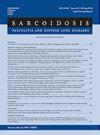Evaluation of respiratory rate monitoring performance using a home oxygen monitoring device among patients with interstitial lung disease and chronic obstructive pulmonary disease
IF 1.8
4区 医学
Q4 RESPIRATORY SYSTEM
Sarcoidosis, Vasculitis, and Diffuse Lung Diseases
Pub Date : 2022-03-31
DOI:10.36141/svdld.v39i1.12133
引用次数: 1
Abstract
Background: Home monitoring devices have been developed to measure adherence to home oxygen therapy. In this study, we evaluated the performance of TeleOx®, a commercially available remote monitoring device, in comparison with polysomnography (PSG) in patients with interstitial lung disease (ILD) and chronic obstructive pulmonary disease (COPD) and the factors that affected TeleOx® correct use. Methods: TeleOx® was connected on the patient or concentrator side. The oxygen flow rates were set at 1, 3, and 5 L/min. Intraclass correlation coefficient (ICC) (2,1) was used to determine the agreement between respiratory rate measured using TeleOx® and that measured using PSG, and the minimum acceptable level of reliability was >0.7. Results: In total, 22 patients (16 with ILD and 6 with COPD) were assessed. In patients with ILD, the detection rate of patients’ respiration assessed using TeleOx® did not change according to the device’s position. It increased from 53.5% to 79.0% by changing the position from the concentrator to the patient side in patients with COPD. The ICC (2,1) value indicated that TeleOx® had acceptable reliability at oxygen flow rates of 1 and 3 L/min regardless of the device’s position in patients with ILD (the concentrator side: 0.9 and 0.82, respectively; the patient side: 0.95 and 0.82, respectively), whereas that did only at the oxygen flow rate of 1 L/min and in connecting TeleOx® on the patient side in patients with COPD (0.73). Conclusion: The monitoring performance of TeleOx® differed according to its position, oxygen flow rates, and patients’ diseases.间质性肺疾病和慢性阻塞性肺疾病患者使用家用氧监测仪监测呼吸频率的效果评价
背景:家庭监测设备已被开发用于测量家庭氧疗的依从性。在这项研究中,我们评估了TeleOx®(一种市售远程监测设备)与多导睡眠图(PSG)在间质性肺疾病(ILD)和慢性阻塞性肺疾病(COPD)患者中的性能,以及影响TeleOx®正确使用的因素。方法:TeleOx®连接于患者侧或浓缩器侧。氧气流速分别设置为1、3、5 L/min。使用类内相关系数(ICC)(2,1)来确定TeleOx®测量的呼吸速率与PSG测量的呼吸速率之间的一致性,最小可接受信度水平>0.7。结果:共评估了22例患者(16例ILD, 6例COPD)。在ILD患者中,使用TeleOx®评估患者呼吸的检出率不会因设备的位置而改变。COPD患者将集中器位置改为患者侧位,从53.5%增加到79.0%。ICC(2,1)值表明TeleOx®在氧气流速为1和3l /min时具有可接受的可靠性,无论设备在ILD患者中的位置如何(集中器侧分别为0.9和0.82;患者侧:分别为0.95和0.82),而COPD患者仅在1 L/min的氧流量和连接TeleOx®时(0.73)才会出现这种情况。结论:TeleOx®的监测效果因其位置、氧流量和患者疾病的不同而不同。
本文章由计算机程序翻译,如有差异,请以英文原文为准。
求助全文
约1分钟内获得全文
求助全文
来源期刊
CiteScore
2.20
自引率
6.20%
发文量
34
期刊介绍:
Sarcoidosis Vasculitis and Diffuse Lung Disease is a quarterly journal founded in 1984 by G. Rizzato. Now directed by R. Baughman (Cincinnati), P. Rottoli (Siena) and S. Tomassetti (Forlì), is the oldest and most prestigious Italian journal in such field.

 求助内容:
求助内容: 应助结果提醒方式:
应助结果提醒方式:


